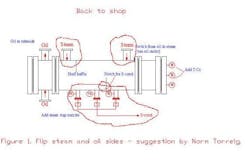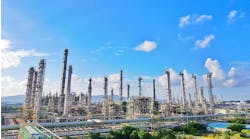THIS MONTH'S PUZZLER
We heat heavy oil with steam before sending it to a reactor. The oil, which is pumped through the shell of the heat exchanger, enters at 100°F and exits at 250°F; 125-psig steam goes through the tubes. The old exchanger had four shell passes and eight tube passes. Someone at corporate engineering mistakenly ordered a heat exchanger with three shell passes and six tube passes. The new shell is rated for 250 psig. The oil/steam overall external heat transfer coefficient is 100 BTU/lb-hr-°F. Is there anything we can do to use this unit so we don't have to order a new heat exchanger and delay production?
SWAP THE STREAMS
Switch the flow of oil and steam, i.e., pump the oil through the six tube passes of the new heat exchanger and the steam on the shell side. Very often the heat transfer coefficient of a liquid on the shell side is relatively low, usually due to a small flow velocity. The heat transfer coefficient of condensing steam is high either on the shell or tube side; it is not sensitive to flow velocity. However, the pressure drop on the oil side will increase, leading to a question regarding the available pump pressure. Therefore, performing a detailed calculation of heat transfer and pressure drop is necessary to make a decision.
Dr. Walter Schicketanz, consultant
Rosenheim,Germany
RAISE THE OIL FLOW RATE
Assuming the area is similar to the current exchanger, I would recommend increasing the oil flow rate and using higher pressure steam if it is available. A higher oil flow rate will increase the overall heat transfer coefficient and the higher steam pressure will raise the log mean temperature difference (LMTD).
Donald Phillips, manager
Phillips Engineering, Melbourne, Fla.
GO BACK TO THE SHOP
As a heat flux of 1,500 BTU/hr-ft2-°F is reasonable, I would move the steam to the shell side. Put the oil through the tubesheet. Knock holes in the baffles to allow steam condensate to escape and add additional nozzles for steam traps — see Figure 1.
Norman Terrelg, production engineer
BASF, Freeport, Texas
RAISE THE STEAM PRESSURE
The obvious solution is to increase the steam pressure, if high pressure steam is available. The highest pressure steam that can be used is about 75% of the shell rating pressure: 0.75 × 250 = 188 psig. If the pressure reaches around 80%, the relief valve may start to open. If we assume 200 psig steam is available, it must be reduced to a safe limit, say, 180 psig.
Flow through a regulator is the same as through a valve or orifice — it is an isenthalpic process, not adiabatic as often is assumed. If we ignore supersonic flow and assume it is unchoked, the temperature drop will be slight. For real gases, a drop in temperature resulting from throttling is described by the Joule-Thompson (Kelvin) coefficient: mJT = (dT/dP)H.
Throttling a wet gas produces a superheated vapor. Using an online calculation program I found by googling "superheat steam table," I estimated a temperature drop of 7.2°F for a drop from 200 psig to 180 psig for a constant total enthalpy of 1,119.3 BTU/lb, which is the total enthalpy of saturated steam at 200 psig. I solved the problem by iterating with the program using the superheated temperature as a variable and the enthalpy of 1,199.3BTU/lb as the target. The steam starts with a saturated temperature of 387.8°F and exits the regulator at 380.6°F — the saturation temperature at 180 psig is 379.5oF. The temperature entering the heat exchanger is 380.6°F.
If I had mistakenly assumed an adiabatic process, the temperature would be: (388 + 460)×[(14.7+180)/(14.7+200)](1.3-1)/1.3 = 829°R (369°F). This is an error of only 3%. The pressure drop is small, but the temperature difference is significant: 12°F.
The original LMTD was: (253 – 153)/Ln (253/153) = 198.8°F; ∆T1 = 353°F – 200°F = 153°F; ∆T2 = 353°F – 100°F = 253°F, where 353°F is the temperature of saturated steam at 125 psig. The new LMTD with 180-psig steam would be: (281-181)/Ln (281/181) = 227°F. Raising the steam pressure increases the LMTD by 14%.
One serious problem with increasing the temperature difference is its effect on thermal expansion inside and outside the heat exchanger. You will want a structural engineer to review the piping; the exchanger manufacturer should look at the effect a higher temperature will have on the tubesheet, internals and the gaskets. Also, check the maximum allowable operating temperature (MAOP); usually 500°F is a convenient limit for carbon steel, but verify.
I considered switching to an oil but the heat transfer coefficient would be in the 100–300 BTU/hr-ft2-°F range, well below the 1,000 expected with steam. With 500°F as a maximum, thermal fluid is out. Electric heating might be a possibility but this would involve a serious overhaul and electric heaters cost about 170% more to operate compared to steam generated by methane.
Now, let's consider some operational options. Recycling the process fluid through for a second pass might make sense if piping allows. This will require new temperature controls to avoid overheating and allowances for thermal expansion of oil trapped in isolated piping.
Another option would be to increase the process flow velocity as high as possible. One of the risks with this choice is tubesheet vibration, which can cause a number of corrosion problems.
Dirk Willard, senior process engineer
Middough Consultants, Holland, Ohio
JULY'S PUZZLER
In our gas plant we pump natural gas liquids (NGL) with a double-suction high-speed centrifugal pump. It runs with a discharge pressure of 60 Barg at 6,700 rpm, and is designed for a flow rate of 670 m3/hr. A booster pump discharges at 20 Barg to the NGL pump suction. The NGL, which has a specific gravity of 0.52, then travels about 400 km to our refinery for fractionation. About 35–40% of the pumped fluid recycles into the surge bullet via a recycle valve, wasting energy. There are other problems: vibration trips in low flow due to shaft deflections, seal leaks, etc. So, we're planning to buy a new pump, preferably one that can save energy and avoid such problems. What type of pump do you consider best for this application?
Send us your comments, suggestions or solutions for this question by June 10, 2011. We'll include as many of them as possible in the July 2011 issue and all on ChemicalProcessing.com. Send visuals — a sketch is fine. E-mail us at [email protected] or mail to Process Puzzler, Chemical Processing, 555 W. Pierce Road, Suite 301, Itasca, IL 60143. Fax: (630) 467-1120. Please include your name, title, location and company affiliation in the response.
And, of course, if you have a process problem you'd like to pose to our readers, send it along and we'll be pleased to consider it for publication.



